As shared in my post last week on Yayoi Kusama, there are no more advanced tickets available for the Yayoi Kusama Infinity Mirrors exhibit in Seattle, but there are always tickets available for the day of your visit if you go there before the museum opens and line up to try getting the first come, first serve tickets at 10 AM. After Seattle, the exhibit goes to The Broad in Los Angeles, and advanced tickets for the exhibit in The Broad go on sale at noon on September 1. If you can’t make it to the exhibit, hopefully the photos and videos I am sharing in this post from when I was visiting Yayoi Kusama Infinity Mirrors at Seattle Art Museum on August 12 will give you at least an idea of how amazing Kusama is.
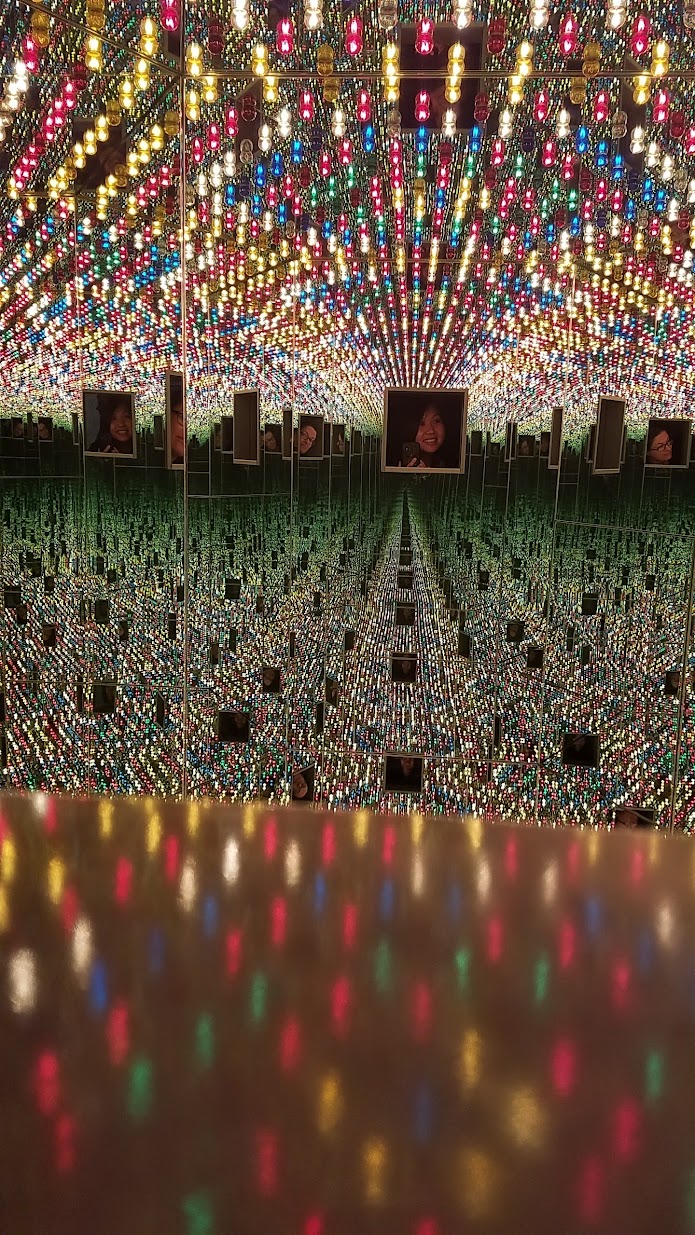

Dots Obsession—Love Transformed into Dots
Yayoi Kusama, Dots Obsession—Love Transformed into Dots, 2007, installed 2017
Vinyl balloons, balloon dome with mirror room, peep-in mirror dome, and video projection
Text from the sign in the exhibit: In 1996, Kusama began creating a series of installations incorporating polka-dotted balloons. Hanging from the ceiling and occupying the floor, these inflatable objects disrupt the viewer’s path. Visitors can enter a mirrored room inside one of the balloons or peer inside another.


Text from the sign in the exhibit: The work engages visitors on contrasting scales: the tiny micro-space seen through a peephole and the macro life-sized space that envelops the viewer within the installation.
Below you can see the peep hole on the left, and then on the right what you see when you peek into it!


A video monitor hanging from the ceiling of the gallery features Kusama singing one of her poems. It is hard to hear the sound unless you are very close in the room, but there is a translation of what she is saying alongside the wall by one of the inflated large pink polka dots that says the following
Translation of “Song of a Manhattan Suicide Addict”
Swallow antidepressants and it will be gone
Tear down the gate of hallucinations
Amidst the agony of flowers, the present never ends
At the stairs to heavens, my heart expires in their tenderness
Calling from the sky, doubtless, transparent in its shade of blue
Embraced with the shadow of illusion
Cumulonimbi arise
Sounds of tears, shed upon eating the color of cotton rose
I become a stone
Not in time eternal
But in the present that transpires


Love Forever
Infinity Mirrored Room—Love Forever, 1966/1994
Wood, mirrors, metal, and lightbulbs
Text from the sign in the exhibit: Infinity Mirrored Room—Love Forever is an iteration of the second mirrored environment Kusama created. Sculptural, architectural, and performative, the installation blurs the lines between artistic disciplines and is activated by audience participation. Hexagonal in shape and mirrored on all sides, Love Forever features two peepholes that invite visitors to peer in and see both themselves and another participant repeated into infinity.


Text from the sign in the exhibit: At the time Kusama created this Infinity Mirror Room, she was experimenting with new technology and viewed the work as a “machine for animation.” During the 1966 exhibition opening of Kusama’s Peep Show, which featured this work, Kusama distributed buttons with the message “Love Forever” printed on them. For the artist, the concept of “Love Forever” stood for civil rights, sexual liberation, the antiwar movement, and the activist groups of the 1960s.
This was a really fun experience – you peek in one at a time, but there are two peekholes available, and unlike the rooms there is no time limit though most people took only a minute or so. I saw lots of kids get very excited and emit little screams of happiness seeing the flashing lights and change in colors. It does feel like a little party in there, and the party is around you as you see your reflection centered among the dancing infinity that feels full of hope and joy.


The Obliteration Room
Yayoi Kusama, The Obliteration Room 2002-present, installed 2017
Furniture, white paint, and dot stickers


Text from the sign in the exhibit: In the Obliteration Room Kusama provides visitors with colorful dot stickers that are to be used to eliminate the traces of the original white room through the act of communal “obliteration”.


Text from the sign in the exhibit: This installation demonstrates her Utopian desire for radical connectivity, which she has described as “a way to free each individual and simultaneously reconnect them in a mutual obligation.”

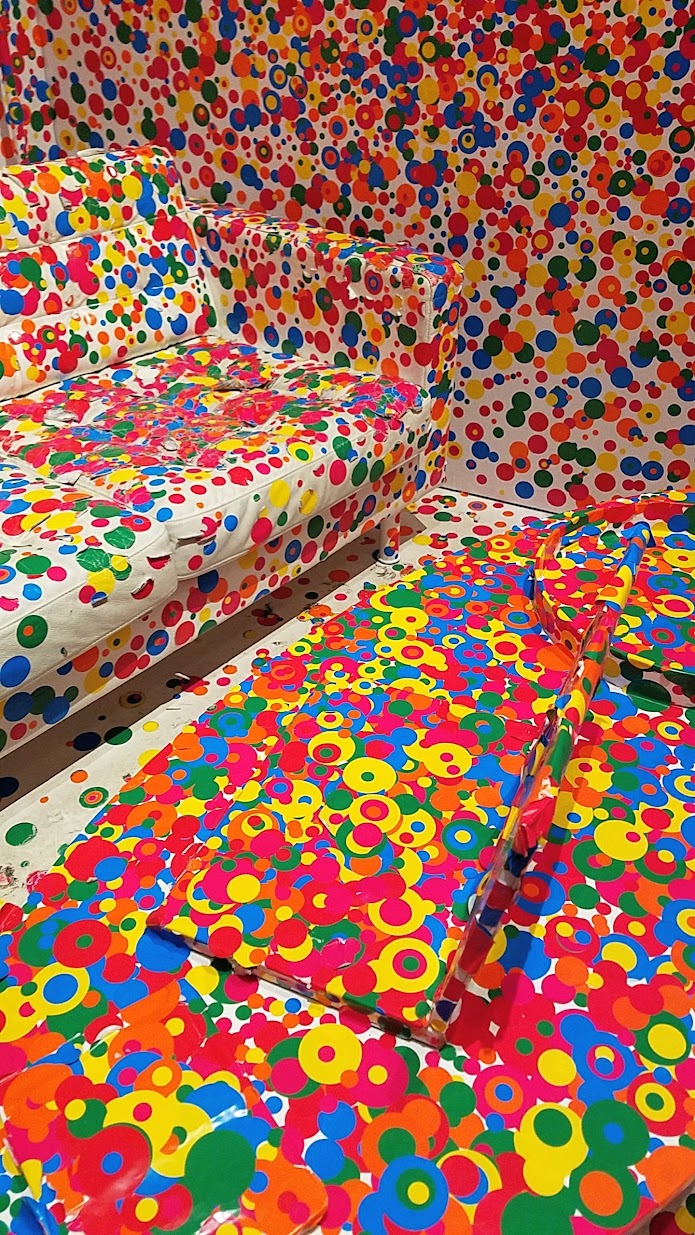
Text from the sign in the exhibit: In this space, the polka dots acts as a universal equalizer, a connector between all of us as we collectively participate in obliterating the environment by placing dots in the installation.


I know I found it truly surreal how with so many stickers there were some objects I could barely recognize what they were originally. At the same time, the stickers brought us all together as we created new forms with the stickers and worked with strangers before and with and after us to build this new environment. Although armed with only a few stickers, the strength of the individual polka dot added up into a transformation.
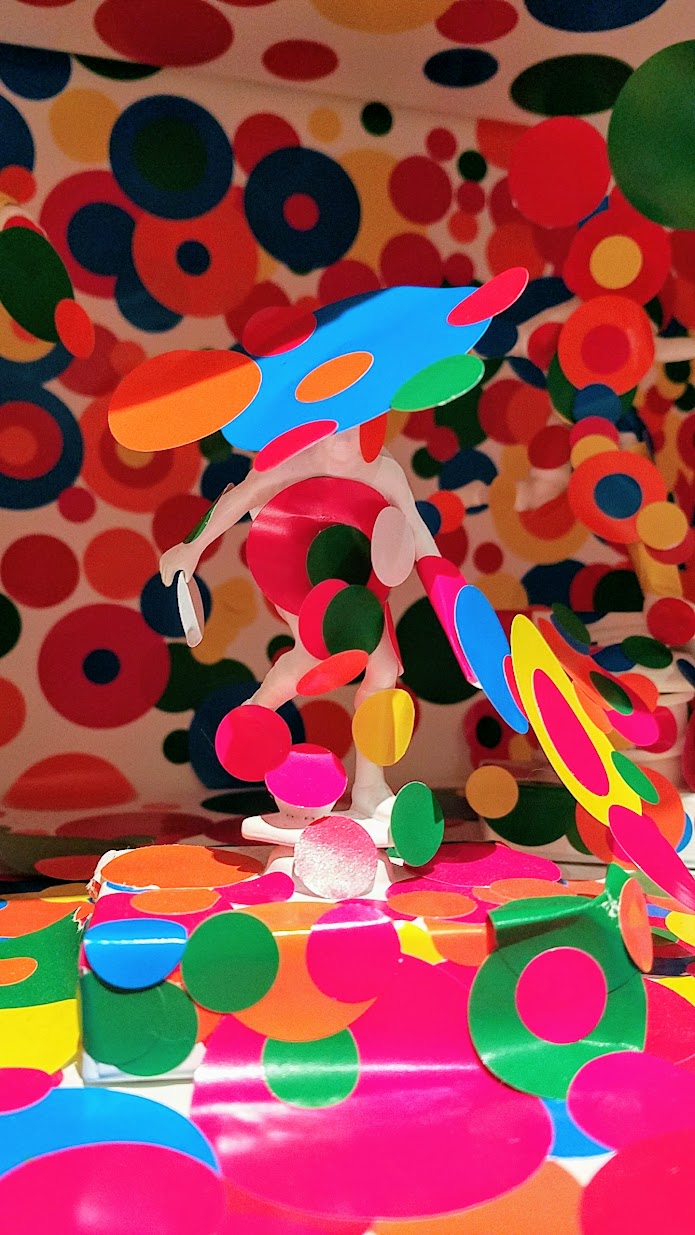

All the Eternal Love I Have for the Pumpkins
Yayoi Kusama Infinity Mirrored Room—All the Eternal Love I Have for the Pumpkins,
2016
Wood, mirrors, plastic, acrylic, and LEDs
I have no photos of this one becasue when the exhibit was in Washington DC, a visitor broke one of the pumpkins while taking photos so now they do not allow photos inside the room.
Text from the sign in the exhibit: Coming from a family that cultivated and sold plant seeds for a living, Kusama saw a pumpkin for the first time during a childhood visit to a seed-harvesting farm with her grandfather. Nestled into the landscape between fields of zinnia, periwinkle, and nasturtium flowers, she spotted an unusually shaped gourd the size of a man’s head. The artist was attracted to the pumpkin for its “charming and winsome form,” celebrating its lumpy, unpretentious, organic shape. The pumpkin motif first appeared in some of Kusama’s drawings from the late 1940s and has repeatedly shown up in her paintings, sculptures, drawings, and installations. Her initial pumpkin mirrored room was staged in 1991 and was later displayed at the 1993 Venice Biennale. Stepping into Infinity Mirrored Room—All the Eternal Love I Have for the Pumpkins, one is transported to a space that recalls fairytales and fantasy. The glowing pumpkins, modeled after the Japanese kabocha squash, are married with Kusama’s signature polka dot pattern within an infinitely repeating space. (Text from the sign in the exhibit)
Aftermath of Obliteration of Eternity
Yayoi Kusama | Infinity Mirrored Room—Aftermath of Obliteration of Eternity, 2009
Wood, mirror, plastic, acrylic, LEDs, and aluminum
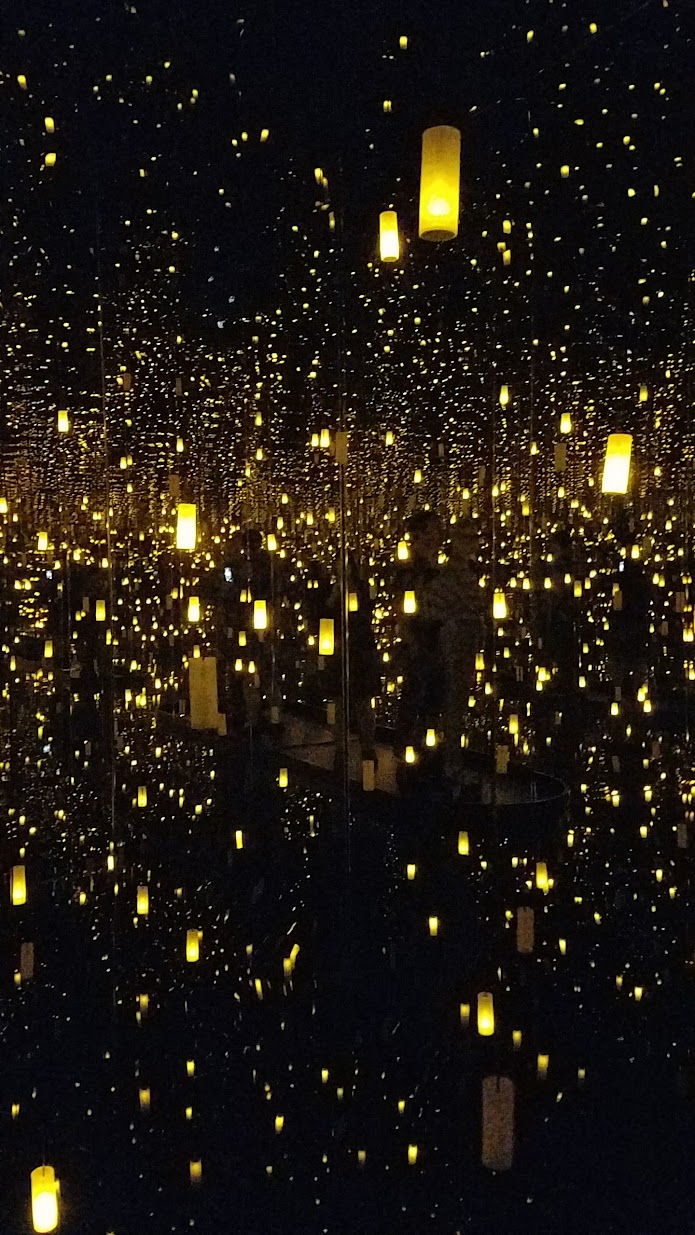
Text from the sign in the exhibit: In Infinity Mirrored Room—Aftermath of Obliteration of Eternity, golden lanterns flicker, creating a shimmering pattern of light that contrasts with the seemingly endless void of the mirrored black space. For Kusama, obliteration is a reflection on the experience of death and the potential of the afterlife.

Text from the sign in the exhibit: The imagery in this work recalls the Japanese tradition of toro nagashi, a ceremony in which paper lanterns known as chochin float down a river to guide ancestral spirits back to their resting places on the final night of the summer obon festivals. The ceremony often commemorates the victims of the atomic bombs. Mesmerizing and intimate, Kusama’s poetic installation underscores the impermanence of life and the certitude of death.
You should expect this Infinity Mirror room to have the longest line. They let 3 people in at a time, so there is also a “singles” line so that if you willing to go in with 2 strangers, you can be the 3rd wheel in the room. This is just one of those rooms that is mesmerizing and better in person then in any video or photo because nothing quite captures the darkness and the flickering light, the mystery and the wonder.
There really is something poignant about this room, and that you naturally walking in, fall into silence. I can see the importance of really limiting how many people are in here to get that feeling of just being one/three small souls in the vastness of the darkness punctuated by points of light. When you first enter some of the lights are still flickering on, and after a few moments when all the lights shine brightly, they also start to go out, and you can really feel as you physically see the fleetingness of human life and time symbolized here start and finish. Yet, the brevity of the experience still feels so meaningful.

My Eternal Soul
Yayoi Kusama, My Eternal Soul
Text from the sign in the exhibit: Begun in 2009, My Eternal Soul currently comprises over five hundred works. Kusama has said that through this series, she hopes to trace the “Beauty of colors and space in the silence of death’s footsteps and the ‘nothingness’ it promises”

- Top row, left to right:
- The Wind Blows, 2016
- Pleasure to Be Born, 2016
- I Love Myself, I Adore Myself So, 2010
- Memory of Love, 2013
- Bottom row, left to right:
- I Who Have Taken an Anti-Depressant, 2014
- My Heart Soaring in the Sunset, 2013
- Searching for Love, 2013
- Sculpture: My Adolescence In Bloom, 2014
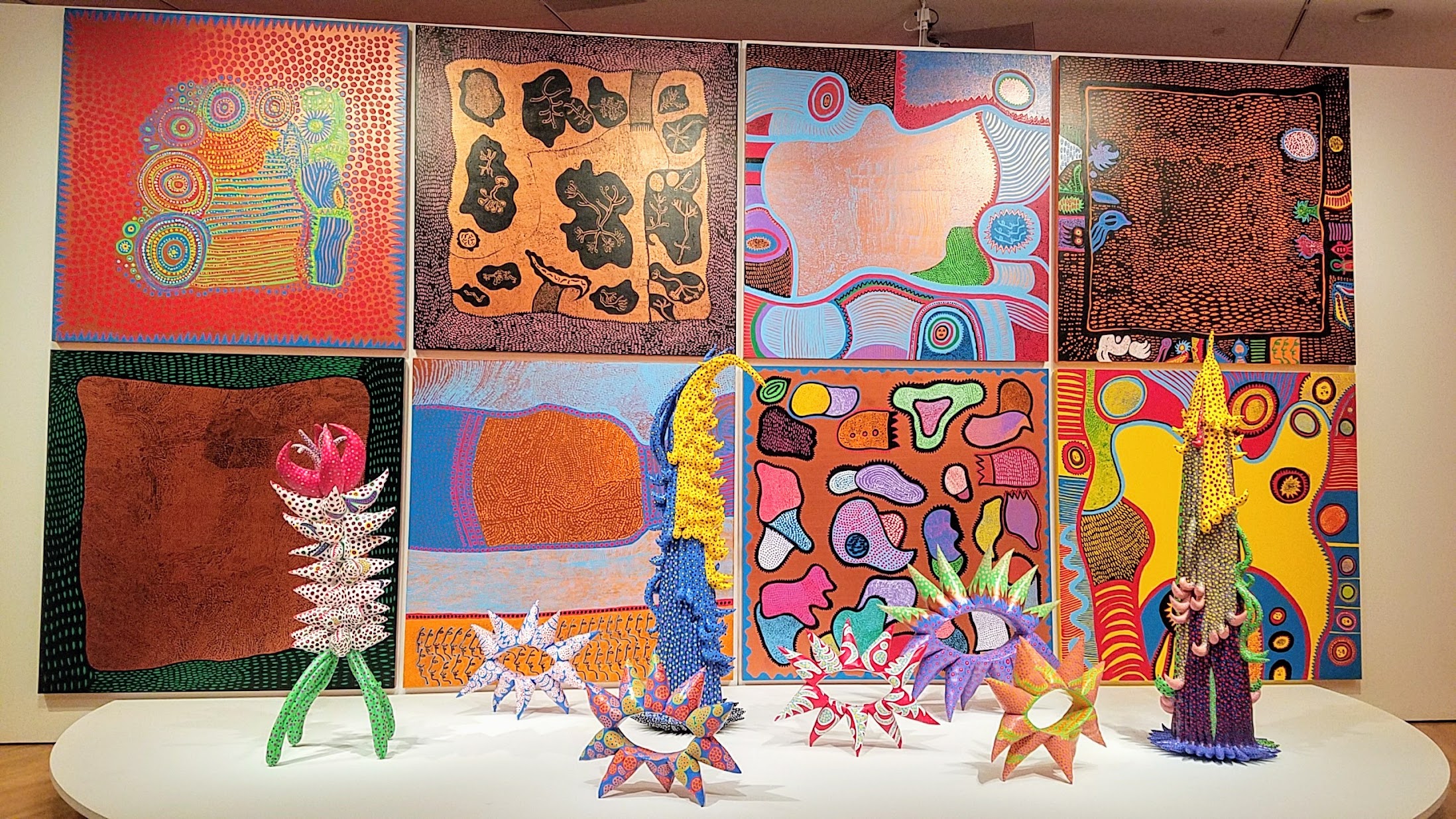
- Top row, left to right:
- Flowers That Bloomed Today, 2012
- Flowers That Bloomed in Heaven, 2015
- Whispering of the Heart, 2015
- Story after Death, 2014
- Bottom row, left to right:
- All About My Heart, 2015
- My Heart’s Abode, 2016
- Aggregation of Spirits, 2016
- Living on the Yellow Land, 2015
- Sculptures, left to right:
- Unfolding Buds, 2015
- The Season of Blossoming Red Buds, 2014
- When the Flower of My Heart Blooms, 2015,
- Surrounded by Heartbeats, 2014
- With All My Flower Heart, 2014
- All About My Flowering Heart, 2015
- My Love is Buried in Ten Petals, 2015
- A Tower of Love Reaches Heaven, 2014
Text from the sign in the exhibit: These paintings embody both the radiance of life and the sublimity of death. The exuburent patterns vibrate with contrasting colors and, much like her early work, are characterized by a tendency towards obsessive, endlessly proliferating motifs and the suggestion of biomorphic forms.




A lot of the sculptures and the paintings are all grouped together here in the front which makes it a little hard to see all the detail unless you make yourself stop and examine the details individually. All of these works seem to be from 2014-2016, so they are what she has been creating most recently (in her age of the mid 80s!). Here’s some detail of “A Tower of Love Reaches Heaven”, 2014. Although for this recent work she continues the motif of dots and an underlying contrast with death, there also seems to be a lot of feeling of energy and life and hope, and I hope she has found some peace and happiness in her pain, and so grateful she found art as therapy to help herself and also to give back to the world.

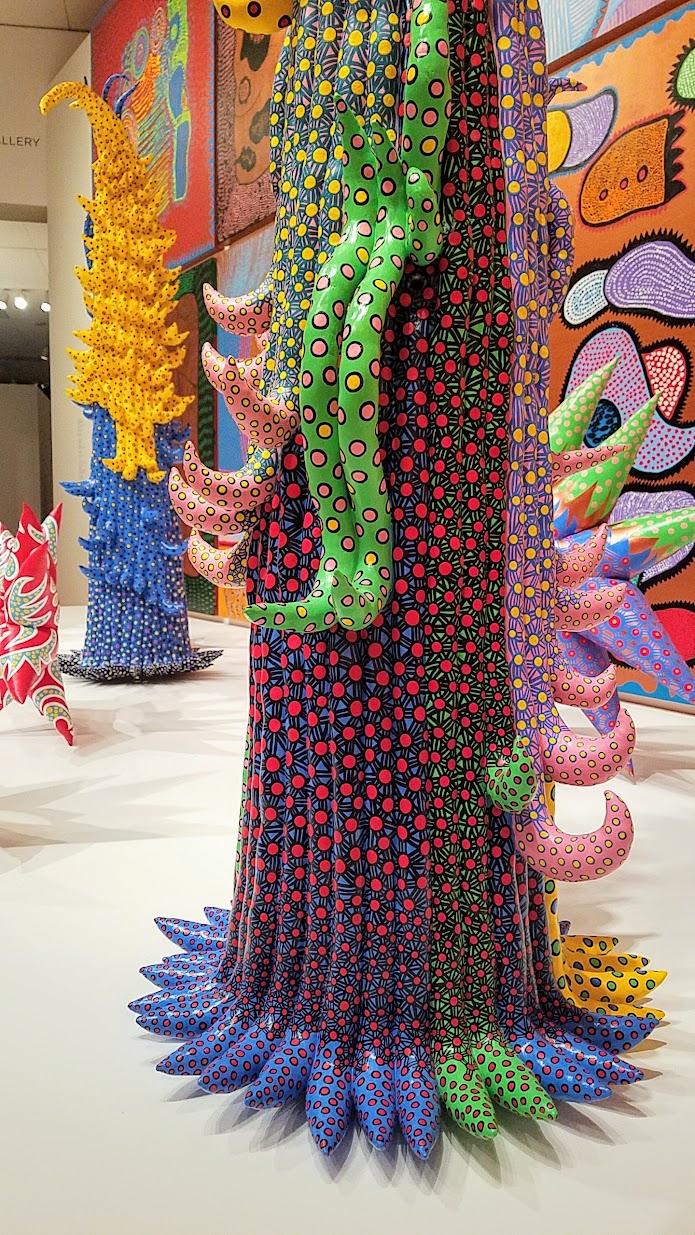
All the sculptures are stuffed cotton, metal, and acrylic paint. My friends and I talked a lot about whether with how consistent the polka dots are whether they are a print – but then there wouldn’t be the paint listed. We just have to recognize she’s just super experienced with decades of polka dots made in her lifetime. This particular one below (with blue) is called “My Adolescence in Bloom”, 2014 and you can feel the exuberance in the patterns and color with its arms but its legs are still short and still feels a little unstable and the foundation is not fully standing yet.


I also like this one, “Unfolding Buds”, 2015 – there’s something about how feminine and sweet but also sassy this one is, and how the white arms reach out into the world and the green legs stand tall and strong but the pink and purple ones at the top are also still tentative and the purple ones still need protection. Meanwhile, in the background you can see the painting with all the orange faces with their gaze.

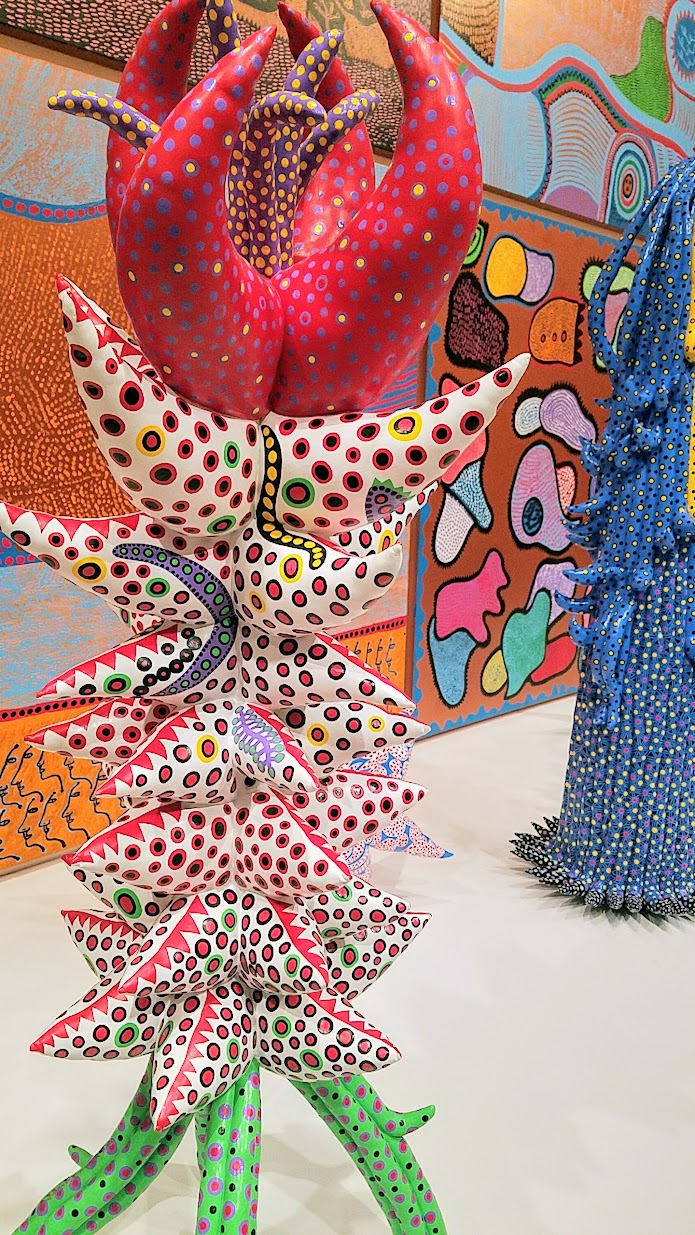
And at the same time, I have been establishing my life by creating my art about some of the strong desires of human beings, such as the beauty of life and the marvelous mystery of the universe. I put my desire for peace, my praise for unpredictable life, and the astonishing mystery of the universe into these 500 plus paintings. The most important thing is that the world is facing many crises right now. We’re getting into the worst century in the history of my life. In this kind of era I will be very happy if everyone can share a common view of human beings for peace in the future and love with the strongest hope…Let’s fight together.
What do you think of what I’ve shared of the Infinity Rooms and other works of Yayoi Kusama, what is your favorite or most fascinating to you? If you want to catch the exhibit, you only have until Sunday September 10. You will need to line up in the early morning for one of the time slot tickets that are first come first serve – your best bet may be Thu-Sat which is when the museum is open until 9 PM.


After September, make your way to The Broad in LA where the exhibit will run from October 21, 2017 – January 1, 2018. It will be also be showing next year in Cleveland and Atlanta, which will be your last chances in the United States. Kusama has made 20 Infinity Rooms, and this is the most ever gathered into an exhibition (5 travelling Infinity Rooms, 6 Infinity Rooms at The Broad because they have a permanent Infinity Room installed, one of 3 existing permanent rooms – only Pittsburgh and the Netherlands also have one). This is a retrospective of almost 7 decades of her work all together, so this is a unique opportunity.











Speak Your Mind